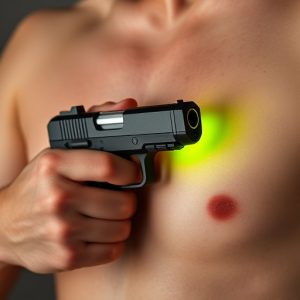Stun Gun Safety & Efficacy: Touch vs. Power for Self-Defense
A stun gun's effectiveness as a self-defense tool relies on its ability to deliver a high-volt…….
A stun gun's effectiveness as a self-defense tool relies on its ability to deliver a high-voltage, low-ampere shock directly to an attacker's skin. Unlike popular misconceptions, proximity alone is not enough; the device must make contact with the assailant's skin to effectively disrupt muscle function and cause temporary immobilization through evenly distributed muscle spasms. When choosing a stun gun, it's crucial to consider models that are designed for efficient skin contact, ensuring they are effective without extensive touch. The best stun guns also feature safety mechanisms like security switches and LED lights, as well as being user-friendly with clear instructions and intuitive designs. Some models even offer practice cartridges to familiarize users before an actual confrontation. In summary, for optimal personal safety, select a stun gun that requires direct contact with the skin, includes additional safety features, and is easy to operate, ensuring you have a reliable tool for self-defense scenarios.
When considering personal safety devices, stun guns stand out as a compelling option for self-defense. For those pondering their effectiveness and whether a stun gun has to touch skin to be lethal, this article delves into the mechanics and market options. We’ll explore the science behind their operation and review top models, guiding readers through the nuances of their effectiveness and ease of use. Join us as we navigate the world of stun guns, ensuring you’re well-informed to make a safe choice for your self-defense needs.
Understanding the Mechanics of Stun Guns: The Need for Skin Contact
When considering the effectiveness of a stun gun for personal safety, it’s crucial to understand its mechanics and operational requirements. A frequently asked question in the realm of self-defense is “Does a stun gun have to touch skin to be effective?” The answer lies in the design of the device and how electric shock stun guns function. Typically, stun guns deliver a high-voltage, low-ampere electrical current that incapacitates an attacker by disrupting muscle control and inflicting intense pain. For this to occur, the probes or electrodes of the stun gun must make contact with the perpetrator’s skin. The current cannot jump across a gap; it requires a conductive path, which is provided by direct skin contact. This ensures that the electrical charge is adequately distributed across the muscle tissues, inducing an involuntary muscle contraction that renders the attacker momentarily immobilized.
Understanding the necessity of skin contact is essential for effective use and can be a game-changer in self-defense situations. While some may believe that proximity alone can render a stun gun useful, this is not supported by the device’s mechanics. The effectiveness of a stun gun is directly tied to its ability to deliver an electrical shock that travels through the body of the target. Without proper contact, the device may produce a spark or light shock but is unlikely to deliver the potent and disorienting experience needed for defense. Therefore, when selecting or using a stun gun, it’s important to consider models with drive stun options, which are designed to be more effective upon direct contact, ensuring the user can confidently rely on the device in critical moments.
Evaluating the Best Stun Guns on the Market: Effectiveness and Ease of Use
When assessing the best stun guns on the market, it’s crucial to consider their effectiveness and ease of use in a variety of self-defense scenarios. A key aspect to evaluate is whether the stun gun requires direct contact with the skin to be effective, as this can significantly influence its practical application during an emergency situation. Many high-voltage models are designed to deliver a powerful electric shock upon touch, disrupting the muscle control of an attacker and causing intense pain without the need for prolonged contact. This feature is particularly important as it can deter an assailant quickly and efficiently. Additionally, the effectiveness of a stun gun is also determined by its safety features, such as a safety switch that prevents accidental discharges, and the bright LED flashlight that can illuminate dark environments or temporarily blind an attacker. The ease of use is another critical factor; the best units come with user-friendly designs, clear instructions, and sometimes practice cartridges to familiarize users with the device’s operation before a confrontation arises. When selecting a stun gun, it’s essential to prioritize models that offer both reliability in performance and user-centric features, ensuring that users are well-prepared to handle potentially threatening situations effectively.


